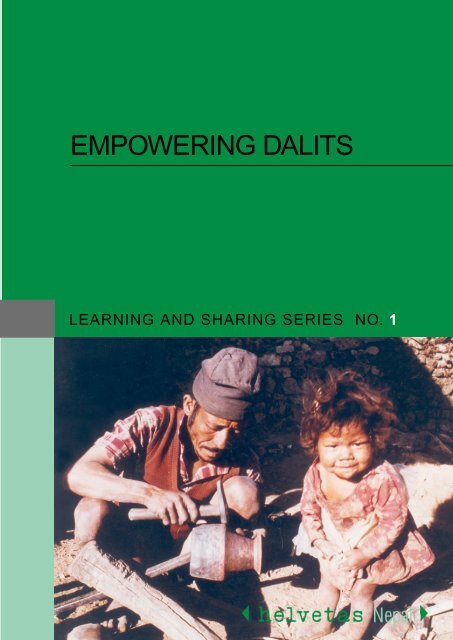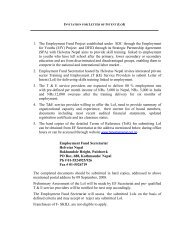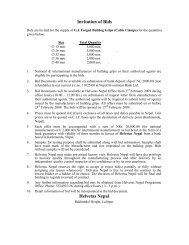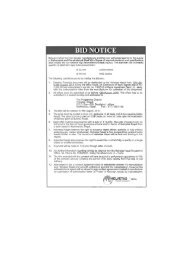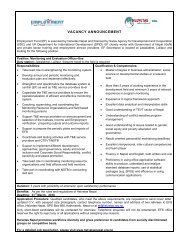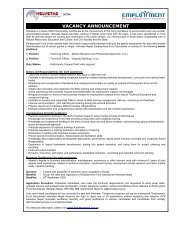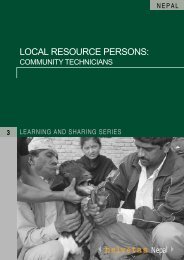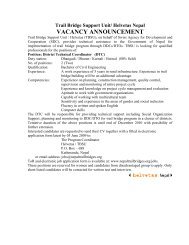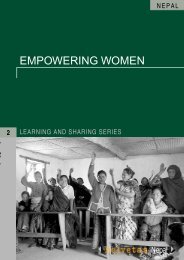EMPOWERING DALITS - Helvetas
EMPOWERING DALITS - Helvetas
EMPOWERING DALITS - Helvetas
You also want an ePaper? Increase the reach of your titles
YUMPU automatically turns print PDFs into web optimized ePapers that Google loves.
<strong>EMPOWERING</strong> <strong>DALITS</strong><br />
LEARNING AND SHARING SERIES NO. 1
<strong>EMPOWERING</strong> <strong>DALITS</strong><br />
LEARNING AND SHARING SERIES NO. 1
No.1 Empowering Dalits<br />
2
HELVETAS NEPAL<br />
Learning And Sharing Series No. 1<br />
<strong>EMPOWERING</strong> <strong>DALITS</strong><br />
Abstract<br />
The empowerment of Dalits is a major challenge for development organisations. Though<br />
the Naya Muluki Ain (New Civil Code) of 1962 and the new constitution of 1990 have sought<br />
to end caste discrimination, and development organisations have supported this, it has<br />
continued.<br />
Empowering Dalits is a<br />
major challenge for<br />
development<br />
organisations.<br />
Dalits are traditionally lower caste people who are regarded as "untouchable," and are<br />
discriminated against socially, economically, and politically. Ninety percent of them live below<br />
the poverty line and have little or no land. In Mid and Far West of Nepal the Dalit population<br />
is proportionally the highest in Nepal, where they form 30% of the population in many districts,<br />
and caste discrimination is extreme here.<br />
Empowering Dalits describes how <strong>Helvetas</strong>' Linking Local Initiatives to New Know-how<br />
(LLINK) programme is reaching and helping Dalit communities in the Mid and Far West of<br />
Nepal. <strong>Helvetas</strong> follows a responsive, step-wise approach of social and economic<br />
empowerment.<br />
<strong>Helvetas</strong> initiates social<br />
and economic<br />
empowerment through a<br />
step-wise approach.<br />
This paper draws attention to the advantages of working directly with Dalit only groups, and<br />
of helping non-Dalits become more aware about the harm discrimination does and about<br />
changing the traditional practices. Experience suggests that Dalit only groups, in the initial<br />
stages, are the best way to help Dalits develop their confidence and leadership. Then, they<br />
can gradually be integrated with non-Dalits and have the confidence to assert their needs.<br />
Dalit communities are<br />
now more unified than<br />
before.<br />
The formation of Dalit support organisations and networks helps further strengthen the<br />
activities of Dalit groups, and helps them put forward their case for equity and equal access<br />
to resources. Dalits have found strength in unity and organisation where previously little<br />
solidarity existed between their communities. Non-Dalits are gradually recognising Dalits as<br />
active members of society. Dalit organisations have been invited to VDC council meetings<br />
and given time to speak.<br />
3 No.1 Empowering Dalits
No.1 Empowering Dalits<br />
4
Contents<br />
Abstract 3<br />
Abbreviations 6<br />
Credo of Rural Reconstruction 6<br />
Introduction 7<br />
Background 8<br />
Rationale For Working With Dalits 8<br />
Approach, Activities And Outcomes 10<br />
Steps - Activities And Outcomes 10<br />
Lessons And Challenges 14<br />
Awareness Motivates 14<br />
Sensitisation Workshops For Non-dalits 14<br />
Dalit Only Groups In The Beginning 14<br />
Building Broad Agreement For Change 14<br />
Access To Benefits In Mixed Groups Can Be Difficult 14<br />
Be Aware That Organisations Can Be Exclusive 14<br />
Indicators Help Provide The Right Support At The Right Time 15<br />
Groups And Organisations Keep Their Activities At A Manageable Level 15<br />
Challenges Facing Groups 15<br />
Challenges Facing Organisations And Networks 15<br />
Impact Of Violent Conflict 15<br />
Helping Dalits Improve Their Livelihoods Takes Time 15<br />
Importance Of Software Work For Income Generation 15<br />
"Tailor Made" Economic Interventions 15<br />
Market And Linkage Support Required 16<br />
Diversification Of Income Generation Activities 16<br />
Dalits Need To Develop The Capacity To Manage The Change Process Themselves 16<br />
Working Exclusively With Dalits Has Nore Immediate Impact 16<br />
Dalit Programme Staff 16<br />
Why Caed's Exclusive Approach Has Been Effective 16<br />
Future Directions 18<br />
1. Awareness Raising and Social Mobilisation 18<br />
2. Building and Strengthening Network and Organisation 19<br />
3. Economic Development and Income Generating Programme 19<br />
4. Complimenting/Supporting Activities 20<br />
5 No.1 Empowering Dalits
Abbreviations<br />
BBLL<br />
CBO<br />
CT<br />
DCPA<br />
FECOFUN<br />
IDEA<br />
ISK<br />
LISP<br />
LNGO<br />
NCPA<br />
NGO<br />
NTFP<br />
OD<br />
PCD<br />
PPRP<br />
PRA<br />
REDA<br />
SLOW<br />
VDC<br />
Bridge Building at the Local Level<br />
Community Based Organisation<br />
Community Technician<br />
District Coffee Producers Association<br />
Federation of Community Forest Users of Nepal<br />
Institutional Development Extension Alliance<br />
Indreni Samaj Kendra (an NGO)<br />
Local Initiatives Support Programme<br />
Local Non-Government Organisation<br />
Nepal Coffee Producers Association<br />
Non-Government Organisation<br />
Non-Timber Forest Products<br />
Organisational Development<br />
People-Centred Development<br />
Participatory Review and Planning<br />
Participatory Rural Appraisal<br />
Rural Economic Development Association<br />
Small farmers, Landless, Occupational caste, and Women<br />
Village Development Committee<br />
Credo of Rural Reconstruction<br />
Go to the people<br />
Live among them<br />
Learn from them<br />
Plan with them<br />
Work with them<br />
Start with what they know<br />
Build on what they have<br />
Teach by showing, learn by doing<br />
Not a showcase, but a pattern<br />
Not odds and ends but a system<br />
Not piecemeal but integrated approach<br />
Not to conform but to transform<br />
Not relief but release<br />
<strong>Helvetas</strong> Nepal and its staff have adopted this credo from James Yen, the founder of the<br />
Global Rural Reconstruction Movement, and bring this into their daily work.<br />
No.1 Empowering Dalits<br />
6
Introduction<br />
This short paper, Empowering Dalits, represents one of a series of Learning and Sharing papers<br />
on various topics of current importance in the <strong>Helvetas</strong> Programme in Nepal. It endeavours<br />
to provide a parallel country-level series to the current Experience and Learning documents<br />
produced by <strong>Helvetas</strong> at the international level.<br />
This paper shares the<br />
experiences of <strong>Helvetas</strong><br />
working in the rural<br />
areas of Nepal.<br />
The paper shares our working experiences in the rural areas of Nepal, as seen by our<br />
operational teams and the staff of their civil society partners. It does not claim to provide an<br />
exhaustive or definitive picture of the topic under discussion. Instead, it is a humble attempt<br />
to document some of our field experiences - a small building block in our learning and sharing.<br />
This documentation will be further elaborated as we accumulate more learning.<br />
This paper focuses on how <strong>Helvetas</strong>, through its Linking Local Initiatives and New Knowhow<br />
(LLINK) programme, is reaching and benefiting Dalit communities within working areas<br />
of Dailekh, Doti, Jajarkot, and Achham districts of the Mid and Far West regions. The<br />
programme supports the promotion of forestry, agriculture, trade-based employment, local<br />
institution building, and social empowerment.<br />
Linking Local Initiatives<br />
and New Know-how<br />
(LLINK) reaches and<br />
benefits Dalit<br />
communities in the Mid<br />
and Far West regions.<br />
The paper explains the rationale behind <strong>Helvetas</strong>' work with Dalits and the basic approach<br />
through which it has supported partners to empower Dalits. The paper outlines the activities,<br />
and outcomes of the Dalit support programme. It draws on <strong>Helvetas</strong>' learning about the overall<br />
approach and activities, and points out the challenges of empowering Dalits. From this, some<br />
future directions are identified for supporting the further development of the Dalit<br />
empowerment programme.<br />
The <strong>Helvetas</strong> approach is<br />
explained by rationale,<br />
activities, outcomes,<br />
learning, and future<br />
directions.<br />
7 No.1 Empowering Dalits
Background<br />
Extreme poverty and<br />
caste and gender<br />
exploitation are<br />
characteristics of the Far<br />
Western districts.<br />
<strong>Helvetas</strong> focuses on<br />
SLOW (Small farmers,<br />
Landless rural people,<br />
Occupational caste<br />
group/Dalit, and<br />
Women).<br />
The working districts of Dailekh, Achham, Doti, and Jajarkot are characterised by extreme<br />
poverty, a lack of rural infrastructure, limited food production, poor resource management,<br />
and underemployment. Weak local governance, migration, and caste and gender exploitation<br />
further compound this situation.<br />
<strong>Helvetas</strong> Nepal applies its "operational vector" of poverty and culture. This is a strategic<br />
framework to ensure that its programmes are poverty oriented and culturally sensitive, and<br />
it focuses on SLOW (Small farmers, Landless rural people, Occupational caste group/Dalit,<br />
and Women). A set of indicators to target SLOW, are applied within the framework during<br />
selecting, planning, implementing and monitoring programmes.<br />
As the LLINK programme reaches its fifth year of operation in 2003, the Mid and Far West<br />
Regions face heightened violent instability. It is an important time for <strong>Helvetas</strong> to review its<br />
experiences and lessons learnt in working with the poor and disadvantaged communities in<br />
remote and now volatile districts of Nepal.<br />
Dalits face entrenched<br />
discrimination within<br />
Hindu society.<br />
Rationale for Working with Dalits<br />
Dalits face deeply entrenched discrimination that Hindu society has practised since the 12th<br />
Century. They are discriminated against in their daily lives at water springs and taps, in<br />
employment, at schools, hotels, restaurants, temples, and milk cooperatives (milk supplied<br />
by Dalits is refused).<br />
Dalits themselves practice discrimination and label "untouchables" within their own caste<br />
group, which has hindered Dalit participation in civil society, the political system, and in social<br />
and economic areas.<br />
Most Dalits live below<br />
the poverty line and<br />
have little or no land.<br />
Dalit occupations<br />
include leather workers,<br />
sweepers, blacksmiths,<br />
tailors, and agricultural<br />
labourers (Haruwa or<br />
Haliya).<br />
90% of all Dalits live below the poverty line and some have little or no land. They suffer<br />
discrimination and marginalisation.<br />
They are poorly educated:<br />
Literacy rate:<br />
Women literacy rate:<br />
18% for Dalits,<br />
48% is national average<br />
58% for Brahmins<br />
3% for Dalits<br />
30% for non-Dalits<br />
They have little access to health facilities:<br />
Average life expectancy: 42 years for Dalits<br />
57 years is national average<br />
61 for Brahmins<br />
They are not aware of good sanitation practices, and Dalit women suffer the double<br />
burden of being women and being Dalit.<br />
Most Dalits receive only<br />
"some food grains" in<br />
payment for their work.<br />
Many Dalits are leather workers, sweepers, blacksmiths, tailors, and agricultural<br />
labourers (Haruwa or Haliya). Most receive only “some food grains” in payment for<br />
their work, and Haliya receive no payment as they work to pay off loans from<br />
landowners – they are effectively bonded labourers.<br />
No.1 Empowering Dalits<br />
8
Dalits are unable to produce sufficient food on small and poor quality landholdings, and have<br />
little or no ability to earn supplementary cash income. In most households, one or two family<br />
members migrate seasonally or permanently to urban centres or to India for low-skilled work.<br />
Nepal’s Muluki Ain (Civil Code) of 1853 legally institutionalised the definition and treatment<br />
of Dalits as “untouchable”. The category “untouchable” was abolished in the Naya Muluki<br />
Ain (New Civil Code) in 1962. Nepal’s new constitution of 1990 made caste discrimination<br />
punishable by law, however this is rarely enforced. Gradually over the last decade, the issue<br />
of caste discrimination has become more prominent and a national level Dalit commission<br />
has been formed to review the Dalit issues and make recommendations for future actions.<br />
Haliya receive no<br />
payment and are bonded<br />
labourers to pay off<br />
loans.<br />
In the Mid and Far West Regions, the practice of untouchability continues despite these legal<br />
changes, and NGO advocacy and programme initiatives. Some development programmes<br />
aimed at addressing caste discrimination have actually neglected and further marginalised<br />
Dalits because of their design and the predominance of higher caste staff.<br />
<strong>Helvetas</strong> has recognised that there is an urgent need for development programmes to find<br />
ways to address the issue of Dalits in the Mid and Far West, and to promote the issue at the<br />
national level through advocacy work. One of the operation objectives of the LLINK<br />
programme is to:<br />
To empower the disadvantaged – women and Dalits – to address the<br />
effects of discrimination and exploitation<br />
Untouchability is still<br />
practised despite legal<br />
changes, NGO advocacy,<br />
and programme<br />
initiatives.<br />
<strong>Helvetas</strong> recognises the<br />
urgent need for<br />
development<br />
programmes to address<br />
the issue of Dalits.<br />
9 No.1 Empowering Dalits
Approach, Activities And Outcomes<br />
The LLINK programme’s<br />
two approaches for<br />
working with Dalits<br />
include:<br />
• Working with Dalits<br />
only groups<br />
• Giving special<br />
attention to Dalits<br />
within mixed groups<br />
<strong>Helvetas</strong> follows a responsive, step-wise approach of social and economic empowerment to<br />
ensure that participants internalise their new capacity at each step and sustain successful<br />
activities. The LLINK programme is testing two approaches to working with Dalits in Achham<br />
and Dailekh districts:<br />
1. Working exclusively with Dalits through the Centre for Agro-Ecology and Development<br />
(CAED), an NGO working in 5 VDCs in Achham; and<br />
2. Giving special attention to Dalits within mixed groups through the NGOs RSDC and SPACE<br />
in 17 VDCs in Dailekh, and Sahavagi in 8 VDCs in Achham.<br />
Both programmes work on raising awareness, addressing the distinct needs and obstacles<br />
faced by Dalits in economic and social programmes, and establishing linkages to regional and<br />
national networks and organisations to advocate and lobby on caste discrimination.<br />
Steps – Activities and Outcomes<br />
Step 1. Groups are<br />
formed through<br />
awareness and<br />
mobilisation activities.<br />
Dalits have taken action<br />
to improve their<br />
situation through critical<br />
self-awareness and<br />
understanding broader<br />
issues.<br />
CAED support has<br />
created unity and<br />
solidarity giving Dalits<br />
confidence and ability.<br />
1. Awareness Raising and Social Mobilisation to form groups<br />
Activities:<br />
• Dalit Sensitisation Workshops for Dalits and non-Dalits – open discussions<br />
on the issues and discrimination confronting Dalits, and ways to address them.<br />
• Group formation and the introduction of confidence building activities:<br />
• Concepts of saving-and-credit activities, accounting and management training, and<br />
access to local resources;<br />
• Discussions within groups on Dalit and women discrimination, rights, health and<br />
sanitation, group membership, and responsibility/confidence for speaking in group<br />
forums;<br />
• On and off-farm skill development/simple agricultural activities for subsistence level<br />
farming<br />
• Specific group activities, like constructing community buildings and school rooms<br />
Outcomes:<br />
Within CAED’s working area, unity,<br />
and solidarity have given Dalits the<br />
confidence and ability to develop a<br />
vision, and recognise their “hopes”,<br />
opportunities, and potential –<br />
important stages in the gradual and<br />
incremental process of social<br />
change. Dalits are gradually<br />
changing their social environment<br />
and being able to enter temples for<br />
worship, to gain support from non-<br />
Dalits, and to be able to send their<br />
children to school.<br />
No.1 Empowering Dalits<br />
10
One Dalit couple from CAED’s working area, explained that when they were drinking tea in the local shop a<br />
Brahmin man asked them to move as he was about to be served. The Dalit replied, “I have no problem to<br />
drink tea with you. If you have a problem, you can move.”<br />
In Siladi, Dailekh district, members of the Dalit network, Dalit Swabalambi Samaj (DSS), on their own initiative,<br />
raised funds to construct a school in their area to make education more accessible for their children.<br />
Additionally, in CAED’s working area in Achham, the local Dalits and the their children’s groups have run a<br />
campaign Send to School, which has helped increase school attendance levels as community pressure is<br />
encouraging families to provide education to their children.<br />
2. Economic Development Activities to develop livelihoods<br />
Activities:<br />
• Advanced skill development and training in:<br />
• Marketing systems and linkages to develop small entrepreneurs, and cultivation and<br />
marketing of Non Timber Forest Products (NTFP);<br />
• Building on traditional practices, cash-crop cultivation with improved and sustainable<br />
farm practices, and keeping small livestock; and<br />
• Trade-based skills training and employment, such as carpentry, house wiring,<br />
hairdressing, tailoring, and leather work.<br />
Outcomes:<br />
Dalit households have increased their income by participating in producer groups. <strong>Helvetas</strong><br />
has introduced cash crops such as chilli, four season beans, and legumes in addition to kitchen<br />
gardening and crops for household consumption.<br />
Step 2. Livelihoods need<br />
to be improved through<br />
Economic Development<br />
Activities.<br />
Producer groups have<br />
enabled Dalits to<br />
increase their income.<br />
Dalits have had training in improved farm practices and technologies for semi-commercial<br />
production and marketing, which has allowed them to utilise: fruit grafting; multi-purpose<br />
nursery management (fruit, NTFPs, fodder and forage); improved forage and fodder cultivation;<br />
seed and vegetable production; and NTFP nursery management and cultivation.<br />
Marketing groups have helped to secure better prices for farmers. Under DEC, a marketing<br />
management committee (MMC) was formed to market the group’s agricultural produce and<br />
NTFPs in the CAED area. NTFP business committees have attracted good prices for timur<br />
(spring pepper), amala, padhina (mint), tulsi (basil), and samayo.<br />
Loan/credit systems<br />
reduce exploitation by<br />
moneylenders.<br />
Dalits in Dailekh and Achham are<br />
participating in saving-and-credit<br />
programmes supported by RSDC and<br />
Sahayagi, in order to generate funds that<br />
can be used to meet urgent household<br />
needs and production activities. The<br />
loan/credit system reduces the<br />
opportunities for exploitation by<br />
moneylenders.<br />
Dalits are now aware of the potential in<br />
occupation-based trades such as<br />
haircutting, tailoring, leatherworking,<br />
house wiring, and sewing machine<br />
repair. A number of Dalit beneficiaries<br />
have already received skills training and<br />
small loans to initiate self-employment.<br />
11 No.1 Empowering Dalits
Rising Solidarity against the Bonds of Halli (bonded labour)<br />
In 1983, Ranga Kham borrowed Rs 80 from the local moneylender. Eighteen years later,<br />
his debt had grown to Rs 12,000. During that period, he was forced to plough fields<br />
and do other work for the moneylender. His “reward” was two meals a day. Ranga was<br />
trapped in halli – a system of bonded labour that never gave him the opportunity to earn<br />
sufficient income for his own family, let alone pay back his growing debt.<br />
Ranga finally got the support of a local Dalit organisation to help him argue for a reduction<br />
of the debt. After a series of tough negotiations, Ranga was able to reduce the debt by<br />
Rs 3,300. He still had to pay back the remaining debt, but could now work elsewhere.<br />
He realised that by working in India he could repay the amount quickly and free himself<br />
from the moneylender.<br />
A CAED co-worker told this story in a Dalit meeting in the CAED centre in Turmakhand,<br />
Achham. “What can we learn from this” he asked. After a few opinions were<br />
expressed, he tapped one finger of his right hand on his left palm.“Can you hear this”<br />
he asked. The reply was “No”. He used two fingers, then three – a light clap was heard<br />
– four fingers and then the whole hand.“Yes, that’s how you can be heard” he shouted.<br />
“United we are strong”. This is the message now spoken amongst Dalits.<br />
Step 3. Organisations<br />
and Networks need to be<br />
strengthened to ensure<br />
continuity.<br />
3. Build and Strengthen Organisations and Networks to ensure continuation of<br />
activities<br />
Activities:<br />
• Small project management, proposal writing, and accessing resources<br />
• Group work dynamics, participation of Dalits and women, participatory review and<br />
planning.<br />
• Coordination and linkages<br />
Outcomes:<br />
Dalits are gaining<br />
strength, unity, and<br />
organisational skills.<br />
Dalits have found strength in unity and organisation where<br />
previously little solidarity existed between their communities.<br />
No.1 Empowering Dalits<br />
12
Local Dalit organisations have been formed and registered:<br />
• Dalit Swabalambi Samaj – Dailekh (DSS): this network is active in advocating Dalit issues<br />
and running simple income generating activities for its members. It has raised support<br />
from the VDCs.<br />
• Dalit Empowerment Committee – Achham (DEC): this network represents Dalit<br />
organisations in 16 VDCs (including those outside <strong>Helvetas</strong>’ working area). It is active in<br />
advocacy and lobbying, organising rural dramas on Dalit discrimination, and successfully<br />
submitting funding requests to Achham DDC and to VDCs. Tosi VDC, in Achham, is<br />
allocating a special fund to the Dalit groups formed under CAED. However, some<br />
individuals take time to change their attitudes. The Tosi VDC chairman said, “Now I can<br />
eat with Dalits, but only outside my village.”<br />
Non-Dalits are gradually recognising Dalits as active members of society. Dalit organisations<br />
have been invited to VDC council meetings and been given time to speak.<br />
Local Dalit leaders are recognised at VDC level and are attracting widespread support from<br />
neighbouring communities and VDCs. In DEC’s first General Assembly approximately 2,500<br />
people from 16 VDCs gathered together. DSS has also hosted mass meetings in Dailekh in<br />
which all Dalit related organisations in the area participated.<br />
Dalits are being<br />
recognised as active<br />
members of society by<br />
non-Dalits and being<br />
given time to speak at<br />
VDC council meetings.<br />
At district level in Achham, Dalit groups and organisations, with the support of the DDC and<br />
other non-Dalit organisations, have formed the Dalit Unity Network.<br />
Using both national and local media, Dalit organisations and members in Dailekh and Achham,<br />
have engaged in national events to air their own agenda and issues.<br />
4. Building on changes to promote changes across a wider area<br />
Activities:<br />
At this step, changes occur and the programme gradually builds on the “new” situation in<br />
order to catalyse the next change.<br />
• Alliance building and networking<br />
• Ilaka and district level network formation<br />
• Linkage development with regional/national level Dalit organisations<br />
• Coordination and linkages with other stakeholders/institutions<br />
Outcomes:<br />
The formation of organisations and<br />
networks described above has lead to<br />
the involvement of more and more<br />
Dalits both within <strong>Helvetas</strong>’ immediate<br />
working area and beyond. Also<br />
productive relationships have been<br />
established with DDCs and VDCs, and<br />
linkages are being developed with other<br />
development organisations and projects.<br />
Step 4. The programmed<br />
must address the "new"<br />
situation and initiate<br />
changes across a wider<br />
area.<br />
Dalits are beginning to<br />
form productive<br />
relationships with DDCs<br />
and VDCs.<br />
13 No.1 Empowering Dalits
Lessons And Challenges<br />
Dalits have been<br />
motivated by The Dalit<br />
Sensitisation Package to<br />
mobilise and take action<br />
towards improving their<br />
situation.<br />
Sensitisation workshops<br />
for non-Dalits, local<br />
institutions, VDCs,<br />
DDCs, and NGOs<br />
promote the Dalit cause.<br />
Dalit-only groups are<br />
more effective than<br />
mixed groups in the<br />
initial stages.<br />
The sensitisation of<br />
stakeholders enables<br />
change, and minimises<br />
conflict.<br />
Monitoring ensures<br />
equal distribution of<br />
benefits and access to<br />
them.<br />
Institutions can become<br />
more important than the<br />
purpose of the movement.<br />
1. Awareness motivates<br />
Critical self-awareness and understanding of boarder issues around discrimination, motivates<br />
participants to mobilise and take action towards improving their situation. The Dalit<br />
Sensitisation Package has helped to increase the awareness amongst Dalits and non-Dalits,<br />
and has motivated the active participation of Dalits in the programmes of <strong>Helvetas</strong>’ partner<br />
organisations. <strong>Helvetas</strong> has significantly increased its work to support Dalits in the last four<br />
years. Intermediary partners have targeted the SLOW more vigorously.<br />
2. Sensitisation workshops for non-Dalits<br />
Ways to build common understanding and support need to be promoted through sensitisation<br />
workshops for non-Dalits, local institutions, VDCs, DDCs, and NGOs. The status quo based<br />
on deeply embedded caste discrimination and social practices is challenged.<br />
3. Dalit only groups in the beginning<br />
At the grassroots in the initial stages, Dalit-only groups are more effective than mixed groups<br />
for enabling Dalits. They enable members to openly discuss issues, identify and address<br />
weaknesses, build on strengths, increase confidence, and develop leadership, which can be<br />
difficult to establish in mixed groups. Members are also more homogeneous in respect to<br />
the availability of resources – time, land, and finances for income generating activities. The<br />
poor involvement of Dalits in mixed groups indicates that other non-Dalit members need<br />
sensitisation.<br />
4. Building broad agreement for change<br />
The sensitisation of a broad range of stakeholders provides the opportunity for developing<br />
consensus for change, and minimising conflict. Dalit issues should not be positioned as<br />
antagonistic to so called “upper caste” interests. Dalit issues must be mainstreamed and a<br />
Dalit movement that will ultimately bring benefits to all must be advocated.<br />
5. Access to benefits in mixed groups can be difficult<br />
Mixed groups need to be monitored to ensure that access and benefits are distributed equally<br />
and fairly. In mixed groups, Dalits have received less access to saving funds and loans (hence<br />
the need for sensitisation of non-Dalits mentioned in an earlier lesson). More effort is needed<br />
to see that Dalits can influence and participate meaningfully in group activities.<br />
6. Be aware that organisations can become exclusive<br />
The question of the institutionalisation of Dalit groups/organisations requires further careful<br />
reflection and testing. It is important<br />
that they are strong and have a feeling<br />
of identity and pride. Then again, it is<br />
important that institutionalisation does<br />
not lead to a new kind of elitism and<br />
formality, since such institutions can<br />
potentially become exclusive rather than<br />
inclusive, and the organisation can<br />
become more important than the<br />
purpose of the movement itself.<br />
No.1 Empowering Dalits<br />
14
7. Indicators help provide the right support at the right time<br />
Indicators that properly identify the stages of group/organisation formation and development<br />
can ensure appropriate support packages are provided at the right time. It is important to<br />
define the role/purpose of the group/organisation in order to clarify its vision, needs, and<br />
activities, and therefore the stages it needs to pass through.<br />
8. Groups and organisations keep their activities at a manageable level<br />
It is important not to over-stretch the capacity, responsibilities, and expectations of the group<br />
or organisation. For example, the newly formed Dalit organisations in Dailekh and Achham<br />
should consolidate their activities on social mobilisation, advocacy, and lobbying activities<br />
before broadening to manage more complex economic programmes. The challenge lies in<br />
developing and implementing the appropriate support packages compatible to the growth<br />
stages of the beneficiary (group/organisation).<br />
9. Challenges facing groups:<br />
• Hand-to-mouth problem – immediate economic needs<br />
• Real felt common issues – untouchability, discrimination, humiliation/suppression<br />
• Defining purpose of group, roles and responsibility in group dynamics<br />
• Confidence in articulating ideas, public speaking and interaction<br />
• Basic skills acquirement<br />
• Lack of solidarity among Dalits<br />
10. Challenges facing organisations and networks:<br />
• Organisational vision and strategy building<br />
• Participatory planning<br />
• Accountability and transparency (in financial management, decision making, membership, etc.)<br />
• Leadership and management<br />
• Resource generation and mobilisation<br />
• Alliance building with similar organisations<br />
• Linkages to local government and other resource organisations<br />
• Management skills for small projects<br />
11. Impact of violent conflict<br />
The LLINK programme and its intermediaries are having difficulty supporting the newly formed<br />
DSS and DEC due to the violent conflict in the region. DSS in Dailekh especially, has been<br />
partially immobilised due to the Maoist activities for the last 12 months and has not been<br />
able to fully carry out its plans. Following the violent attacks in Achham in March 2002, it is<br />
likely that CAED and DEC will face similar obstacles. Consequently, there is a pressing need<br />
to build the capacity of local organisations to manage activities themselves.<br />
12. Helping Dalits improve their livelihoods takes time<br />
It has taken approximately two to three years to bring Dalit participants from a hand-to-mouth<br />
existance to a sustainable subsistence level of production for household consumption, from<br />
which income generating activities and cash crops can be introduced.<br />
13. Importance of software work for income generation<br />
Awareness, social mobilisation, and group activities have given Dalits confidence and a vision<br />
of what they are doing as well as an understanding of why they are doing it. This has then<br />
helped make income generating activities a success.<br />
14. “Tailor made” economic interventions:<br />
Economic programmes need to address the specific conditions and challenges facing Dalits<br />
in the region. Programmes and activities must be suitable for Dalit farmers who<br />
characteristically avoid risks, and therefore, must start by promoting a balance between food<br />
production and cash crops to minimise the risks. Short-term benefits with long-term economic<br />
development plans, goals, and activities are needed for Dalit farmers, who are adverse to<br />
taking risks.<br />
Indicators help provide<br />
the right support at the<br />
right time.<br />
It is important not to<br />
exceed the capacity of<br />
an organisation.<br />
Groups face many<br />
challenges.<br />
Organisations and<br />
Networks also face many<br />
challenges.<br />
Conflict and violence<br />
have hindered the LINK<br />
programme.<br />
Improving the situation<br />
of Dalits takes time.<br />
Income generation is a<br />
success due to social<br />
mobilisation efforts and<br />
creating awareness.<br />
Economic programmes<br />
need to address the<br />
conditions and<br />
challenges Dalits endure.<br />
15 No.1 Empowering Dalits
Market support and<br />
linkages are essential for<br />
Dalit enterprises.<br />
Dalits need to find<br />
alternative sources of<br />
income.<br />
Communities should<br />
take up activities<br />
themselves and manage<br />
change in a sustainable<br />
manner.<br />
There is immediate<br />
impact when working<br />
exclusively with Dalits<br />
on Dalit issues.<br />
Dalits should be<br />
encouraged to facilitate<br />
programmes.<br />
15. Market and linkage support required<br />
Strong support to creating markets and linkages is essential at the initial stages of economic<br />
programmes to build confidence and commitment in Dalit groups.<br />
16. Diversification of income generation activities<br />
Modernisation is displacing many traditional occupations. As ready-made goods flood in from<br />
China and India, potters, cobblers, tailors, and others are facing less demand for their trades.<br />
Dalits need to diversify their skills.<br />
17. Dalits need to develop the capacity to manage the change process<br />
themselves<br />
One concern is in what direction and on what scale can this momentum continue Is there<br />
any real local capacity to continue and manage the radical process of change for which Dalit<br />
communities have now been mobilised To address the interrelated political, social, and<br />
economic facets of Dalit poverty and discrimination in a balanced way, it is necessary when<br />
implementing programmes to enable the communities themselves to take up the activities<br />
and to manage the change process in a sustainable manner. So far, most intermediaries have<br />
been unable to fully deal with these issues.<br />
18. Working exclusively with Dalits has more immediate impact<br />
When comparing the two different approaches taken by <strong>Helvetas</strong>’ intermediaries to<br />
empowering Dalits, it is clear that working exclusively with Dalits, like CAED is, has had a<br />
more obvious impact on Dalit issues. In Achham, CAED’s strong initiation and support leads<br />
to more participation, profile, and momentum in the active pursuit of Dalits’ rights compared<br />
to neighbouring programmes.<br />
19. Dalit programme staff<br />
A programme officer from the Dalit community has helped the LLINK programme team and<br />
its intermediary partners to follow-up on those activities focused on Dalits, and improve their<br />
effectiveness.<br />
Why has CAED’s exclusive approach been more effective, so far, in attracting<br />
the active participation and support of the Dalits<br />
CAED's exclusive<br />
approach has enabled<br />
Dalits themselves to<br />
take centre stage in<br />
their own development<br />
activities.<br />
1. Dalit ownership of the organisation<br />
CAED has a genuine, announced, and committed agenda to support the Dalit community and<br />
their needs and hence, is perceived by the community to be working directly for Dalits. CAED<br />
has earned the community’s trust and now the community invites and welcomes the<br />
organisation’s presence. Local Dalits believe that CAED is their organisation. This has helped<br />
Dalit communities to accept CAED. As CAED’s programme director, Devendra Adhikari, who<br />
is from a high caste, states, “Where you first put your feet is extremely important.”<br />
2. Interpersonal skills, relationship building, and identifying the Dalits’ own<br />
issues are important<br />
Through close interaction, CAED has demonstrated patience, openness, and the ability to listen<br />
and allow Dalits themselves to speak out on what is important to them. CAED was able to<br />
identify and start with the issues of untouchability and social discrimination amongst the Dalit<br />
community. This is further reinforced by the LLINK programme’s adherence to the Credo of<br />
Rural Reconstruction (see Annex ).<br />
CAED’s unique way of working with Dalit couples creates change from within<br />
by building on existing resources and knowledge<br />
No.1 Empowering Dalits<br />
16
3. Working through local Dalit couples strengthens understanding and relations<br />
Dalit couples selected from local Dalit families are responsible for establishing resource and<br />
learning centres, supporting their village area in the dissemination of new skills and knowledge,<br />
and promoting education on Dalit issues through the centres. The couples’ responsibility and<br />
service to their area creates change from within, builds on the existing resources and<br />
knowledge, and generates confidence and a realisation of their own potential. However, it<br />
has also created some jealousy and resentment within the community. Others may perceive<br />
that the selected couples receive most of the benefits. These issues need to be addressed.<br />
4. Outside intervention can help people change their attitudes<br />
CAED has given the Dalit community as sense of hope. Previously, Dalits did not believe<br />
that external intervention and programmes could make a positive difference and bring<br />
beneficial changes in their lives. CAED has broken the fatalistic attitude of helplessness, so<br />
that they can realise their own potential. This is the point from where a change in perception<br />
can begin.<br />
5. Community spirit and solidarity created<br />
CAED has generated a community spirit and solidarity that is spreading amongst Dalits in<br />
the district. From this, they are forming groups and organisations.<br />
6. Demonstrating in practice that traditional discriminatory practices are<br />
unfounded<br />
Hiring a Dalit cook for the CAED centre in Turmakhand is an example of implementing small<br />
initiatives that generate huge impact. This action immediately changed and broke the practice<br />
of segregated eating due to untouchability. As CAED hosts meetings and workshops at its<br />
centre, non-Dalits, who usually refuse food from Dalits or do not eat in their company, have<br />
to either lose face by not taking tea and food, or to consent and eat with the mixed community.<br />
This small but effective action helps non-Dalits to realise that taking food and eating with<br />
Dalits has absolutely no consequences. Many other organisations now watch CAED’s new<br />
initiatives with keen interest, and some have adopted similar activities.<br />
7. Introducing new interventions<br />
first to Dalits builds relations<br />
with others in the community<br />
Dalits cannot easily copy the activities of<br />
the higher castes because they lack the<br />
same resources – house, water,<br />
animals, land, education, knowledge,<br />
and exposure. If activities and skills are<br />
introduced to Dalits first, then these can<br />
trickle upwards, and the Dalits gain<br />
greater respect in the community. For<br />
instance, the higher castes have said, “If<br />
Dalits are doing it, why aren’t we” and<br />
copied kitchen gardening, toilet<br />
construction, breaking chaupadi<br />
customs, and cooperative registration.<br />
When the non-Dalits also benefit from<br />
these interventions, resentment is<br />
reduced.<br />
17 No.1 Empowering Dalits
Future Directions<br />
<strong>Helvetas</strong>’ future plan of<br />
action includes:<br />
• Increase sensitisation<br />
• Use specific support<br />
packages for Dalits<br />
• Adopt a gradual<br />
approach<br />
• Understand Dalits’<br />
perspective<br />
• Build sustainable<br />
capacity of community<br />
organisations<br />
• Follow up on support<br />
• Strengthen linkages<br />
The outcomes and the lessons learnt from the experience of <strong>Helvetas</strong> and its partners<br />
demonstrate that to bring Dalits into the mainstream of the development process the following<br />
actions are required:<br />
• Increase the effort to sensitise Dalit and non-Dalit communities about Dalit issues,<br />
including both government and non-government institutions;<br />
• Work with support packages specific to Dalits that consider and tackle the distinct social,<br />
economic and political dimensions of the discrimination and poverty experienced by Dalits;<br />
• Be patient and responsive to a gradual and incremental change process and have a clear<br />
view of the world as Dalits see it;<br />
• Build the capacity of local community organisations/institutions to continue the change<br />
process activated by external intermediaries;<br />
• Facilitate and follow-up groups with due attention to ensure that Dalits have the capability<br />
to carry out programmes independently; and<br />
• Develop and strengthen linkages between Dalits and non-Dalits.<br />
Based on these actions and lessons, the modifications to the steps for the empowerment of<br />
Dalits, like that of the <strong>Helvetas</strong>’ LLINK programme, are:<br />
Awareness raising and<br />
social mobilisation takes<br />
two to three years.<br />
The Dalit Sensitisation<br />
Package/Workshop is at<br />
the core of the<br />
programme.<br />
Local resource persons<br />
must be trained to<br />
facilitate workshops.<br />
Action to eliminate<br />
untouchability has<br />
created interest and<br />
enthusiasm from Dalit<br />
participants.<br />
Various forms of media<br />
must be explored and<br />
utilised for advocacy.<br />
Dalits can interact with<br />
mixed groups and<br />
organisations once they<br />
have confidence.<br />
1. Awareness raising and social mobilisation<br />
Awareness raising and social mobilisation is a two – three year process with the direct<br />
intervention by the programme and its intermediary partners in the community.<br />
Begin by sensitising all programme and partner staff on Dalit issues, and ensure that the Dalit<br />
Sensitisation Package/Workshop is a core and regular component of the programme. After<br />
this sensitisation, the programme and partner organisation can develop a clear policy and<br />
strategy for implementation in the community.<br />
Intermediary partners and any newly forming organisations will train their own members to<br />
conduct Dalit sensitisation workshops. Local resource persons can then facilitate the<br />
workshops at the member, community, and broader local organisation level. Follow up will<br />
include workshops and support to identified technical and economic opportunities.<br />
Continue to focus on identifying and starting from common, real felt issues. Experience<br />
indicates that action on untouchability has raised the interest and enthusiasm of Dalit<br />
participants. For future directions and action, this insight can help partners to address issues<br />
that will motivate and guide the participants constructively. In workshops with the groups,<br />
partners will facilitate discussions that are based on specific issues. Participants will be guided<br />
on how they themselves can address the issues of discrimination of Dalits and women,<br />
untouchability, rights, health and sanitation, and group membership and responsibility.<br />
Explore and utilise various forms of media, including radio, posters and newspapers, to<br />
advocate and promote Dalit issues within the communities, districts and regions.<br />
Wherever possible, intermediary partners continue to encourage the formation of Dalit only<br />
groups to run their activities. This enables intermediary partners to give Dalits the specific<br />
support and time required for the members to gain confidence. As members begin to gain<br />
more confidence and are able to articulate their ideas and arguments, then the partners can<br />
begin to help create opportunities for the groups and their members to interact with mixed<br />
groups and organisations of Dalits and non-Dalits.<br />
No.1 Empowering Dalits<br />
18
Promote and support the inclusion of non-Dalits in Dalit community education programmes<br />
such as rural dramas, folk songs and dance competitions, gatherings, marches, and<br />
interactions with local government bodies. The involvement of non-Dalits will contribute<br />
positively to the process of social change, to build greater understanding and cooperation in<br />
the wider community, and minimise potential conflict and resentment that may emerge as<br />
traditional beliefs and practices are challenged.<br />
2. Building and Strengthening Networks and Organisations<br />
Give special attention to build and consolidate the capacity of Dalit community and<br />
membership organisations in order to continue with the empowerment process and manage<br />
activities giving support to members. Community-based Dalit organisations can play a<br />
prominent role in the process of political and social change.<br />
Non-Dalits can<br />
contribute positively to<br />
the process of social<br />
change.<br />
Special attention must<br />
be given to<br />
strengthening networks<br />
and organisations.<br />
Dalit Swabalambi Samaj was formed to represent Dalits in Dailekh by working on social<br />
mobilisation, advocacy, and lobbying. The organisation carries out economic and income<br />
generating activities for members in coordination with other cooperatives, agencies, and<br />
programmes.<br />
Dalit Empowerment Centre is an organisation formed in southern Achham to take over<br />
all the technological and social activities currently managed by CAED. It has been<br />
registered as a local network organisation representing Dalits in 16 VDCs.<br />
Community-based Dalit<br />
organisations can bring<br />
political change.<br />
Such organisations demand significant organisational development with support for:<br />
• Identification and clarification of issues and purposes<br />
• Organisational vision and strategy<br />
building<br />
• Organisational management training<br />
and skill development – proposal<br />
and report writing<br />
• Leadership development – vision,<br />
commitment and ability to mobilise<br />
• Alliance building/strengthening,<br />
representation and influence at local<br />
government level<br />
• Resource generation and access<br />
Dalit organisations need<br />
structural support.<br />
As the organisations get stronger and<br />
mature, the external programme can<br />
offer opportunities for support through<br />
small grants and the potential of<br />
entering into partnerships to implement<br />
activities as an intermediary partner.<br />
3. Economic development and income generating programme<br />
Introduce farm-led income generating activities based on people’s interest and potential, once<br />
Dalit groups have stabilised their subsistence level of production for household consumption<br />
(a process of approximately two – three years after raising Dalit awareness and Dalit<br />
mobilisation activities).<br />
Economic development<br />
and income generating<br />
programmes are<br />
introduced after a period<br />
of mobilisation and<br />
awareness activities.<br />
19 No.1 Empowering Dalits
The risks involved in<br />
new commercial<br />
initiatives are minimised<br />
by a balance between<br />
cereal and cash crop<br />
production.<br />
Activities are improved<br />
by applying experiences<br />
and lessons learned.<br />
Continue to initiate and support income generating activities that address conditions specific<br />
to Dalits households, including:<br />
• Risk averse<br />
• Small landholdings, often with poor soil conditions and irrigation facilities<br />
• Minimal access to credit and capital<br />
• Migration of household members<br />
• Lack of demand for traditional occupational skills<br />
Promote a balance between the production of cereals (food crops) and cash crops to minimise<br />
the greater risks of new commercial (small-scale) initiatives. Viable interventions are:<br />
• Introduce inter-cropping of cereal and selected cash crops, such as chilli, legumes, and<br />
four-season beans (this will improve soil fertility).<br />
• Continue agro-technical skill development with an emphasis on applying and consolidating<br />
the skills in the field.<br />
• Offer special credit/loan facilities for productive activities and differentiated support<br />
subsidies for Dalits.<br />
• Explore opportunities to foster and promote the role of Dalits (who have unproductive<br />
land or no land) as business agents to collect and market local produce.<br />
• Give preference to Dalits for trade-based (traditional and new) skill development and<br />
employment opportunities.<br />
• Develop and promote the potential of leasing community land or farms by Dalits for<br />
income generating activities.<br />
• Expand the programme to promote small livestock with loan facilities and a revolving<br />
fund system, especially targeted at the participation of Dalit women.<br />
• Continue to promote and support the participation of Dalits in the management of NTFP<br />
collection, cultivation, and marketing.<br />
4. Complimenting/Supporting Activities<br />
Learning from experiences and applying the lessons in future plans improve programme<br />
activities. In future:<br />
• Encourage Dalits to lead the monitoring of activities and their evaluation.<br />
• Institute the use of poverty oriented checklists and indicators to ensure activities focus<br />
on the poor.<br />
• Incorporate lessons learnt in future activities.<br />
• Support local governments in poverty/SLOW oriented planning, programme<br />
implementation, and evaluation.<br />
No.1 Empowering Dalits<br />
20
Swiss Association for International Cooperation<br />
Bakhundole Height, Pulchowk, GPO Box 688, Kathmandu/Nepal


